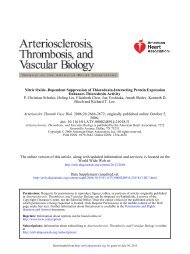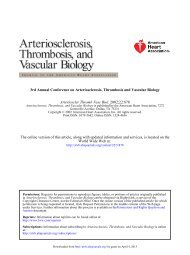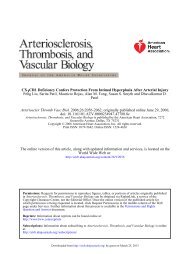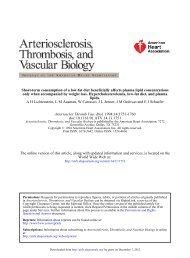Physiologic and Supraphysiologic Increases in Lipoprotein Lipids ...
Physiologic and Supraphysiologic Increases in Lipoprotein Lipids ...
Physiologic and Supraphysiologic Increases in Lipoprotein Lipids ...
Create successful ePaper yourself
Turn your PDF publications into a flip-book with our unique Google optimized e-Paper software.
Blood Sampl<strong>in</strong>g<br />
PREGNANCY HYPERLIPIDEMIA AND PRELIPEMIA Montes et al. 409<br />
Blood samples <strong>in</strong> pregnant <strong>and</strong> postpartum women<br />
were obta<strong>in</strong>ed by a research nurse <strong>in</strong> each subject's<br />
home to m<strong>in</strong>imize the effects of stress on fuel<br />
<strong>and</strong> lipoprote<strong>in</strong> homeostasis. Nonpregnant subjects<br />
came to the Northwest Lipid Research Cl<strong>in</strong>ic for<br />
blood draw<strong>in</strong>g. All subjects had fasted for 12 to 14<br />
hours before the sampl<strong>in</strong>g. About 35 ml of venous<br />
blood were obta<strong>in</strong>ed from subjects who were sitt<strong>in</strong>g.<br />
The blood for lipid analysis conta<strong>in</strong>ed 1.5 mg EDTA<br />
per ml blood <strong>and</strong> was kept on ice until centrifuged <strong>in</strong><br />
the laboratory. The blood for glucose estimation was<br />
collected <strong>in</strong> tubes conta<strong>in</strong><strong>in</strong>g 2.5 mg sodium fluoride<br />
<strong>and</strong> 2.0 mg potassium oxalate per ml blood.<br />
Lipoprote<strong>in</strong> <strong>and</strong> Apoproteln Analyses<br />
Plasma samples were overla<strong>in</strong> with 0.9% sal<strong>in</strong>e<br />
<strong>and</strong> ultracentrifuged <strong>in</strong> a 40.3 rotor at 40,000 rpm at<br />
17° C for 18 hours. 9 The top 2 ml were analyzed as<br />
very low density lipoprote<strong>in</strong> (VLDL). The bottom fraction<br />
was brought to a measured 5 ml with sal<strong>in</strong>e <strong>and</strong><br />
analyzed as the d > 1.006 fraction. Another 3 ml of<br />
whole plasma was treated with hepar<strong>in</strong> <strong>and</strong> MnCLg<br />
to precipitate VLDL <strong>and</strong> low density lipoprote<strong>in</strong><br />
(LDL), allow<strong>in</strong>g measurement of high density lipoprote<strong>in</strong><br />
(HDL) lipids <strong>in</strong> the supernatant. 9 ' 10 The apo B<br />
content of the supernatant fraction never exceeded 2<br />
mg/dl by immunoassay. LDL lipid concentrations<br />
were determ<strong>in</strong>ed as the difference between the d <<br />
1.006 <strong>in</strong>franatant <strong>and</strong> HDL. Triglyceride <strong>and</strong> cholesterol<br />
were measured us<strong>in</strong>g the AutoAnalyzer II<br />
method. 9<br />
Apolipoprote<strong>in</strong> B (apo B) was measured <strong>in</strong> total<br />
plasma <strong>and</strong> VLDL by a double antibody radioimmu-<br />
noassay as previously described. 11 LDL apo B was<br />
calculated as the difference between total plasma<br />
<strong>and</strong> VLDL apo B. Apolipoprote<strong>in</strong> A-l was measured<br />
on whole plasma by a radial immunodiffusion method<br />
after tetramethylurea delipidation. 12<br />
The ratios of triglyceride/cholesterol <strong>and</strong> lipid/apoprote<strong>in</strong><br />
<strong>in</strong> each lipoprote<strong>in</strong> fraction are presented as<br />
<strong>in</strong>dices of lipoprote<strong>in</strong> composition.<br />
Statistical Analyses<br />
The mean, st<strong>and</strong>ard deviation, <strong>and</strong> median described<br />
lipoprote<strong>in</strong> lipids, apoprote<strong>in</strong>s <strong>and</strong> ratios for<br />
the nonpregnant controls <strong>and</strong> the antepartum <strong>and</strong><br />
postpartum subjects. Nonparametric statistical<br />
methods were used for significance test<strong>in</strong>g because<br />
of the small sample sizes. Wilcoxon's matched pairs<br />
test 13 was performed to determ<strong>in</strong>e if significant differences<br />
existed between antepartum <strong>and</strong> postpartum<br />
measurements <strong>and</strong> between 6- <strong>and</strong> 20-week postpartum<br />
values. The Wilcoxon rank sum test 13 was<br />
used to detect differences between controls <strong>and</strong> antepartum,<br />
6-week, <strong>and</strong> 20-week postpartum subjects.<br />
Mean values <strong>and</strong> 95% confidence <strong>in</strong>tervals<br />
were used to graphically illustrate antepartum-topostpartum<br />
changes.<br />
Results<br />
<strong>Physiologic</strong> Hyperllpldemla In Pregnancy<br />
Table 2 presents the antepartum-postpartum lipoprote<strong>in</strong><br />
observations <strong>in</strong> subjects with physiologic<br />
hyperlipidemia <strong>in</strong> pregnancy <strong>and</strong> matched nonpregnant<br />
controls. Selected lipoprote<strong>in</strong> lipid <strong>and</strong> apoprote<strong>in</strong><br />
changes are illustrated <strong>in</strong> Figure 1. Ratios of<br />
Table 2. Plasma Lipoprote<strong>in</strong> Lipid <strong>and</strong> Apoproteln Concentrations (mg/dl) <strong>in</strong> 23 Women In Late<br />
Pregnancy <strong>and</strong> Postpartum <strong>and</strong> <strong>in</strong> 23 Age- <strong>and</strong> Body-Mass-Matched Nonpregnant Controls<br />
Total<br />
Triglyceride<br />
Cholesterol<br />
Pregnant<br />
Weeks 34-38<br />
Mean±SD Median Mean<br />
222 ±60<br />
251 ±32<br />
223*<br />
244*<br />
VLDL<br />
Triglyceride 107 ±41 100*<br />
Cholesterol 22 ± 9 20*<br />
ApoB 20±11 23*<br />
LDL<br />
Triglyceride<br />
Cholesterol<br />
ApoB<br />
HDL<br />
Triglyceride<br />
Cholesterol<br />
ApoA-1<br />
72 ±21<br />
161 ±39<br />
84±23<br />
29 ±9<br />
64 ± 9<br />
164+16<br />
70<br />
151*<br />
81*<br />
26*<br />
65*<br />
167*<br />
Week 6 Week 20<br />
±SD<br />
71 ±23<br />
205 + 23<br />
Postpartum<br />
Median Mean ± so<br />
66t<br />
204*t<br />
29±18 23t<br />
7±4 6*f<br />
4±3 4t<br />
27 + 10<br />
124±21<br />
104±17<br />
8±3<br />
64±12<br />
127±22<br />
26*t<br />
127*t<br />
103*f<br />
9*t<br />
62*<br />
130t<br />
'Significantly different from controls at p s 0.05.<br />
tSignificantly different from antepartum at p < 0.05.<br />
^Significantly different from 6 week postpartum at p < 0.05.<br />
66±18<br />
190±28<br />
Median<br />
62t<br />
187*t*<br />
28±16 21t<br />
6±5 5't<br />
4±2 4t<br />
23±7 21*t<br />
120 ±24 120't<br />
88 ±16 90*tt<br />
8±4<br />
56±11<br />
132±16<br />
10t<br />
131f<br />
Downloaded from<br />
http://atvb.ahajournals.org/ by guest on June 29, 2013<br />
Nonpregnant controls<br />
Mean±sD<br />
59±19<br />
171+26<br />
33±14<br />
11+6<br />
7 + 6<br />
14±10<br />
104±23<br />
61 ±10<br />
12±6<br />
56±12<br />
128±23<br />
Median<br />
58<br />
165<br />
31<br />
10<br />
6<br />
13<br />
103<br />
62<br />
11<br />
53<br />
124














